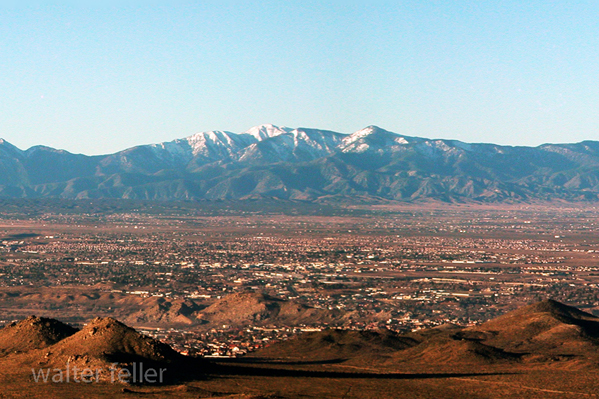Homesteaders & Hucksters:
1880 - 1920

During the latter part of the Nineteenth Century the area quietly grew as ranchers and miners moved into and out of the area. Prospectors were making finds throughout the desert and they and the cowboys working for the several cattle outfits helped earn the little village of Victor a reputation as one of the tougher towns in which to spend a Saturday night.
Preceding the arrival of the railroads a firm of San Franciscans, the Fairchild- Gilmore-Wilton Co. brought 60 Scandinavian stonecutters to work in the marble and granite quarries located throughout the valley. In addition to the granite paving blocks, curbstones and horse blocks cut and polished at Victor, the paving contractors established ranching operations and at one time even maintained apple and pear orchards. Their Victor Ranch grew feed for the threehorse teams used in hauling stone while the quality of their orchard products led to the installation of apple presses and the sale of apples and apple juice "from the Apple Valley" up and down the state.
The coming of rail transportation introduced a new settler along the banks of the Mojave. Having Federal grants of huge land holdings, the railroads began to engage in the real estate business on a scale never seen before. In their attempts to induce potential land buyers to California they began a price war on rail tickets that at one point saw the fare from Kansas City to Los Angeles drop to $1.00 per passenger.
The Southern Pacific, with large holdings in the Victor Valley, promoted the township of Hesperia and was able to command higher prices for their lots than were obtained for tracts in and around Los Angeles. For nearly a decade (1880- 1888) land speculators in all of Southern California feverishly bought and sold lots, tracts, townships and dreams. The population of the southern part of the state multiplied seven or eight times before the boom crashed, and even afterwards Victor Valley saw immigrants arriving from the East (described as anyplace the other side of the Colorado River) seeking a new life in the healthy desert climate.
Following in the tracks of the railroads, land developers such as the Appleton Land & Water Co. and Ursula M. Poates continued to promote real estate around the "gateway: to the Golden Land of Opportunity." the colorful, dynamic Mrs. Poates advertised lots in newspapers everywhere and is credited with the naming of Apple Valley, derived from her 640-acre "City of Apple" filed in 1893. Mrs. Poates' efforts were later overwhelmed by the Federal Government, which, shortly after the dawn of the 20th Century opened thousands of acres to homesteaders. Undaunted by government giveaways, in 1900 she attempted to create a town called Pearl Park (named after one of her daughters) in conjunction with the Southern Pacific.
In the early 1900s, the desert began to be dotted with little homesteader's shacks "proving up" (making the minimum required improvements) the land. Serious attempts were begun to cultivate the Valley and by 1910 there were 17 apple orchards totaling 1,000 acres in addition to the extensive cattle ranches. In 1912 developer Arthur E. Hull and his associates arrived on the scene, fresh from their triumphant founding of Beaumont, California. Hull enlisted the assistance of Los Angeles newspaperman Max Ihmsen in promoting the agricultural potential of the area, organized both a Victor Valley Boosters Club and the Victor Valley Chamber of Commerce and his various companies such as the Apple Mesa Development Co., and the California Land and Water Co. Offered at prices from $5 to $25 per acre, lots were ballyhooed across the country, railroad excursions to the Valley were organized (sleeper cars had to be pressed into service as hotels at one point) and the AT&SF Rwy gave away over 300,000 apple trees to land buyers during 1913 and 1914 alone. In addition to publicizing the area, Hull also worked diligently at improving the value of everyone's holdings. Picturing the possibilities of the area, he lobbied and worked to obtain the first paved highway across Cajon Pass and was instrumental in obtaining additional water for his lands through legislation and other means. In 1914, Max Ihmsen's apples took top honors at the California State Apple Show, and growers were earning from $350 to $500 per acre of apples. Within a year and a half, the State legislature and the Federal government had authorized the Victor Valley Water Project, largest of its era in the nation, and the Santa Fe Railway began to lay double trackage to serve the anticipated needs of Victor Valley. So euphoric were Hull and his contemporaries about the future, (they even opened membership in their Chamber of Commerce to women) in October, 1916 they plunked down the staggering sum of $2.5 million for the Arrowhead Reservoir & Power Co.
Six months later, the dream disappeared. On April 17, 1917 the United States entered World War I. Soon thereafter, young farmers, homesteaders, dam builders, and cow-hands began to march off to fight Kaiser Bill in Europe, and Arthur Hull quietly sold off Mariana Ranch (named for a wife tragically killed years earlier), to the Bandini family.
The miners and ranchers who had witnessed this boom went back to their diggings and cattle. The great day for the valley they loved was yet another 50 years away in the future.
< previous - next >